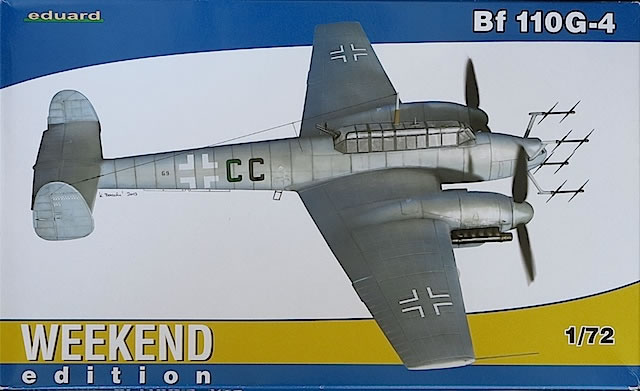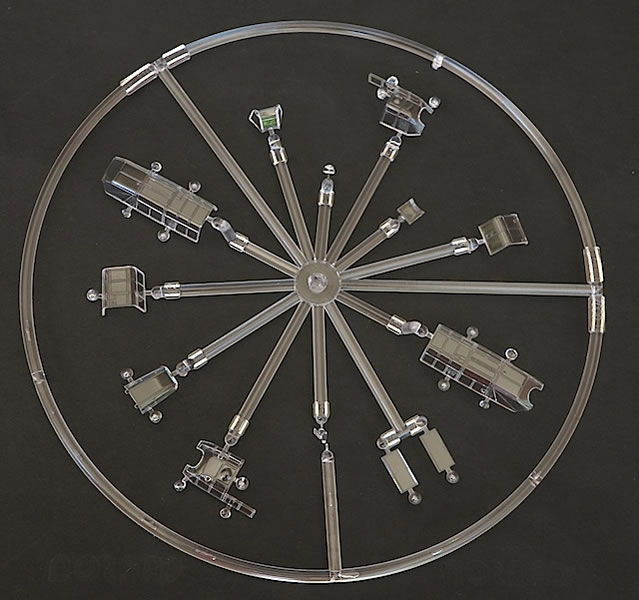|
Messerschmitt
Bf 110 G-4

Eduard Weekend Edition, 1/72 scale
S
u m m a r y |
| Catalogue Number: |
Eduard Kit No.7422 – Bf 110 G-4 Weekend Edition |
| Scale: |
1/72 |
| Contents and Media: |
Approximately 215 grey coloured plastic parts (81 unused); 13 clear plastic parts (3 unused); 1 decal sheet containing markings for 1 aircraft. |
| Price: |
USD$19.51 plus shipping available online from Eduard’s website |
| Review Type: |
FirstLook |
| Advantages: |
Accurate, well-moulded plastic parts; interesting marking option. |
| Disadvantages: |
|
| Conclusion: |
This kit is a welcome addition to Eduard’s 1/72 Bf 110 family. The plastic parts are excellent in terms of accuracy, moulding and buildability. The finished model will have enough detail to look good without the photo-etch parts and other inclusions that are found in Eduard’s Profipack kits, and Adolf Breves’ aircraft is an interesting choice as marking option. The longer I look at this kit, the closer it gets to the top of my ‘build now’ list. |
Reviewed by Brad Fallen

Eduard's Weekend Edition 1/72 Messerschmitt Bf 110 G-4
is available online from Squadron.com for only USD $20.66
The Messerschmitt Bf 110 G-4 was the final and most numerous production version of the Bf 110 series. Approximately 2,000 G-4s were built between the end of 1942 and early 1945, representing one-third of all Bf 110s constructed and the backbone of Germany’s late war night fighter force. Their obsolescence and increasing vulnerability to Allied night fighters notwithstanding, G-4s took a heavy toll of Allied bombers until the end of hostilities. Most Bf 110 G-4s were camouflaged in RLM 76 Light Blue overpainted with a topside disruptive pattern – often in RLM 75 Grey Violet, but there were many variations in colour and pattern, including machines that were overall RLM 76.
Eduard launched its 1/72 Bf 110 family in mid-2012 with a Bf 110 E Profipack.
Brett Green reviewed the kit here and concluded that it was “a beautifully detailed kit with class leading surface detail” and “a viceless build with almost perfect fit….Eduard has now snatched the mantle of “Best Bf 110 in 1/72 scale….””
Eduard has followed this initial release with seven more boxings:
Bf 110 E Weekend Edition
Bf 110 C/D Profipack
Bf 110 D Weekend Edition
Bf 110 G-2 (Profipack and Weekend Edition)
Bf 110 G-4 Profipack
Bf 110 C-6 Limited Edition
These kits have received similarly favourable comments on their accuracy and buildability. Brett observed in his review of the Bf 110 G-2 Profipack that “Eduard's Messerschmitt Bf 110s are some of the best mainstream 1/72 scale kits ever produced”.
Eduard has now added a Bf 110 G-4 Weekend Edition to this range, with markings for an aircraft flown by 17 victory ace and II./NJG 1 commanding officer Hauptmann Adolf Breves in December 1944.
This is the first good look I’ve had at one of Eduard’s 1/72 Bf 110 kits, and I can see what the fuss is about. As a Weekend Edition the kit does not have the canopy masks, multiple decal options, full colour instruction booklet or photo-etched and Brassin details of an Eduard Profipack kit. However, the box still contains one clear and seven grey plastic sprues for a total parts count of nearly 230. Even with over 80 of these parts not required for this build and destined for the spares box, this still leaves a healthy number of parts for a 1/72 scale twin engined aircraft model.
More impressive than the number of parts is their quality. The panel lines and access hatches on the main airframe components are probably the finest I have seen on a 1/72 scale kit – deep enough to take a wash but restrained enough to retain an ‘in scale’ appearance on the completed model. The delicate rivet detail is also a highlight.
This finesse is carried over to the smaller parts. Moulding quality is excellent, with no flash and narrow sprue attachment points; the only flaws I found were sink marks on the end of two ammunition drums. Some of the parts are so small and/or thin they may be tricky to remove from their sprues without damage. The drop tank sway braces and – particularly – the radar mounts and dipoles fall into this category. With careful assembly the mounts and dipoles should look very convincing, but for those modellers who want a finer array on their model, Eduard produces a photo-etched replacement set that is available separately.
The cockpit is particularly well appointed, made up from over 25 parts that after painting and weathering should look appropriately busy and convincing. Two instrument panel options are provided, one a blank panel onto which a decal is applied, and the other a panel with moulded-on dials. I’ll probably use the decal option because I’m not very good at painting instrument dials, but the panel with the moulded detail is worth close examination because it’s an example of injection-moulding at its best – you can almost see the instrument needles in the dials! As usual I recommend installing some aftermarket seat harnesses in the cockpit, as their absence will be obvious under the glasshouse canopy.

And Eduard’s canopy parts are very good: thin, clear and with well-defined framing. This is another area of the kit where patience will be necessary during assembly. Designed to be assembled open or closed using almost all the same parts, the canopy is made up from nine parts that will need to be carefully aligned and in one case (if you’re positioning the canopy open) modified. Study the instructions closely when you’re doing this – the illustrations for assembling the canopy are very busy at first glance.
Overall however the instructions are well produced in the typical Weekend Edition style of a 12-page black and white booklet. Assembly is called out in a logical sequence through generally clear illustrations. The painting and marking guide on the last page is also in black and white, but colour views of the subject aircraft are provided on the side of the box and a full colour painting and marking guide can be downloaded from Eduard’s website.
Marking Option
As mentioned above, the single marking choice provided is for Bf 110 G-4 ‘G9+CC’ based at Dusseldorf, Germany and flown by Hauptmann Adolf Breves when he was commanding officer of II./NJG 1 in December 1944. ‘G9+CC’ is finished in what is probably my favourite Luftwaffe night fighter scheme of overall RLM 76 Light Blue. This scheme sounds monochromatic but in reality was anything but, given the wear and tear and exposure to the elements to which these machines were subjected. The two photographs I’ve found that claim to be of the kit marking option (the codes aren’t visible in either image) suggest that this was the case with ‘G9+CC’, with the RLM 76 paint job looking faded and worn. The challenge of recreating such a finish, along with the splashes of RLM 23 Green on the fuselage codes and port spinner, make this aircraft an interesting and attractive marking choice. At the same time, the simplicity of the RLM 76 scheme will appeal to modellers who are interested in a Luftwaffe night fighter subject, but daunted by the often complex camouflage on these machines.
The small decal sheet has been produced by Eduard and is noteworthy because it contains not only well-printed, crisp national markings and codes, but also a full set of airframe stencils. I haven’t seen stencils provided in a Weekend Edition kit for several years, presumably as a cost-cutting measure to keep the price of the kits down. However they are a welcome addition here, because ‘G9+CC’’s other markings are quite sparse and the stencils will add interest to the finished model. Be warned, though, that some of the stencils are extremely small – for example, the fuselage station numbers. Some of these decals are almost certain to become casualties during application; fortunately spares are provided!
A stencil placement guide isn’t included in this kit, but one can be found on Eduard’s website here.
This Bf 110 G-4 Weekend Edition kit is a welcome addition to Eduard’s 1/72 Bf 110 family. The quality of the plastic parts is excellent in terms of accuracy, moulding and buildability. The finished model will contain enough detail to look good without the photo-etch parts and other inclusions that are found in Eduard’s Profipack kits, and Breves’ aircraft is an interesting choice as marking option. The longer I look at this kit, the closer it gets to the top of my ‘build now’ list – highly recommended.
Thanks to Eduard for the sample
Review Text and Images Copyright © 2014 by Brad Fallen
Page Created 16 April, 2014
Last updated
17 April, 2014
Back to HyperScale Main Page
Back to Reviews Page |
